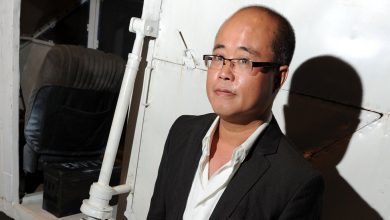Blaming Trump, Jan. 6 Suspect Says He Fell Down a ‘Rabbit Hole’ of Lies

WASHINGTON — Dustin Thompson’s trip down what he called “the rabbit hole” of election misinformation began eight months before a single vote was cast in 2020. It ended inside the United States Capitol on Jan. 6, 2021, where he was part of the mob of Trump supporters that stormed inside during Congress’s counting of electoral votes in the worst attack on the building since the War of 1812.
An exterminator from Columbus, Ohio, Mr. Thompson, 38, was laid off in March 2020, at the start of the pandemic. Alone at home with his new wife, he began spending long days on the internet, steeping himself in conspiracy theories about the upcoming vote.
As the election approached, he said, he fully believed that if Donald J. Trump ended up losing, it would only be because the voting had been rigged, as the president had been warning publicly for months. Even after Joseph R. Biden Jr. was declared the winner, Mr. Thompson could not accept that it was true.
All of this, he told a jury at his criminal trial on Wednesday, led him to Washington on Jan. 6 for a Stop the Steal rally, where he and a friend listened to Mr. Trump give an incendiary speech near the White House.
In an hour on the witness stand, Mr. Thompson blamed Mr. Trump for what eventually occurred, saying that he had been answering the president’s call to go to the Capitol and “fight like hell” when he joined the throng swarming into the building and made off with a bottle of bourbon and a coat rack.
“If the president’s giving you almost an order to do something,” he said, “I felt obligated to do that.”
Mr. Thompson’s story is not unusual. At several points during the Justice Department’s vast investigation of the Capitol attack, many people charged with crimes have sought to blame Mr. Trump in various ways for their actions, mostly at pretrial bail hearings or at sentencings after pleading guilty.
But Mr. Thompson is the first defendant to attempt the argument at trial in front of a jury. In making his case, he offered a window into the toxic and relentless flood of conspiracy theories and lies, stoked by Mr. Trump, that helped give rise to the riot.
The move comes with considerable risk, and its success or failure could determine not only Mr. Thompson’s fate, but that of other defendants accused of taking part in the violence of Jan. 6.
Before the trial began, Mr. Thompson admitted to prosecutors that he had gone into the Capitol and stolen government property, agreeing in advance to nearly every element of the six charges he faces. His defense will rest almost entirely on the question of his state of mind during the riot.
Mr. Thompson has claimed that he did not knowingly or corruptly break the law, but rather, as his lawyer said on Tuesday, was “so influenced — so used and abused” by Mr. Trump that he could not be held accountable for his behavior.
The Trump-made-me-do-it defense has not fared well with judges. While it could work better on a jury, Mr. Thompson seemed to stumble on Wednesday during cross-examination, undercutting key elements of his argument.
William Dreher, a prosecutor, got him to admit several times that Mr. Trump had not been at his side, offering him step-by-step instructions, when he walked into the Senate parliamentarian’s office and walked out with the whiskey and the coat rack. Mr. Thompson acknowledged that he was a married adult with a college degree who could make his own decisions.
Mr. Thompson also conceded under questioning by Mr. Dreher that he had known it was unlawful to go into the Capitol on Jan. 6 while lawmakers were finalizing the results of the election. That appeared to contradict a central pillar of his own defense.
While Mr. Thompson’s claims that he was under Mr. Trump’s spell do not carry any legal weight as evidence, they echo similar allegations the government has made in other cases connected to Jan. 6. In those cases, prosecutors have gone to great lengths to describe how rioters at the Capitol were motivated by Mr. Trump’s statements, including his speech at the Ellipse and a tweet he posted on Dec. 19, 2020 calling on his followers to attend a “wild” protest in Washington on Jan. 6.
Capitol Riot’s Aftermath: New Developments
Debating a criminal referral. The Jan. 6 House committee has grown divided over whether to make a criminal referral to the Justice Department of former President Donald J. Trump, even though it has concluded that it has enough evidence to do so. The debate centers on whether a referral would backfire by politically tainting the expanding federal investigation.
A Trump ally agrees to cooperate. Ali Alexander, a prominent organizer of pro-Trump events after the 2020 election, has agreed to cooperate with the Justice Department’s newly expanded investigation of the attack on the Capitol last year.
The effort to disqualify “insurrectionists.” New lawsuits were filed against three Arizona officials, including Representatives Paul Gosar and Andy Biggs, to bar them from office under the 14th Amendment. This is part of a larger legal effort to disqualify G.O.P. lawmakers from re-election if they participated in events surrounding the Jan. 6 attack.
Contempt charges. The House voted to recommend criminal contempt of Congress charges against Peter Navarro and Dan Scavino Jr., two close allies of Mr. Trump, after the pair defied subpoenas from the special committee investigating the Jan. 6 attack.
First acquittal. A federal judge decided that a man who claimed that the police let him into the Capitol during the Jan. 6 riot was not guilty of four misdemeanors, the first acquittal connected to the sprawling investigation of the attack.
Well before the trial began, Mr. Thompson’s lawyer, Samuel H. Shamansky, made a bold request of the judge in the case, Reggie B. Walton, asking for permission to subpoena Mr. Trump as a witness. Judge Walton ultimately rejected the move, saying that hauling the former president into the courtroom would only have been a distraction.
Instead, at his trial this week, Mr. Shamansky has painted Mr. Thompson as an impressionable man who filled his days of pandemic-driven isolation with a steady diet of election fraud conspiracy theories. Mr. Thompson agreed that a “perfect storm” of circumstances, as Mr. Shamansky put it, had caused him to fall prey to Mr. Trump’s lies about the race and ultimately led him to the Capitol.
“It was just an awful year — being unemployed, newly married, quarantine, Covid,” he told the jury. “I don’t know where my head was.”
Before Mr. Thompson offered his account, his wife, Sarah Thompson, took the stand.
Mrs. Thompson, who works in the corporate offices of Victoria’s Secret, told the jury that she was a Democrat who had voted for Mr. Biden and never believed the “conspiracy theory-type” material she increasingly saw her husband looking at on YouTube, Twitter and various other websites.
Still, she said it had been “a rough year” for the couple, who were married in January 2020 after 12 years of dating. She told the jury that Mr. Thompson’s anger about the election appeared to have grown worse because he was stuck at home without a job.
“Dustin spent a lot of time on the internet,” she said.
When he went off to Washington on Jan. 5, she said, driving with a friend, Mrs. Thompson did not think that her husband would get into trouble. She was happy, as she put it, to be at home with the “house quiet.”
But on the evening of the riot, Mr. Thompson texted her a video of himself, milling about with others in the looted parliamentarian’s office. The room was littered with paperwork and overturned furniture.
Her response to him was simple and direct.
“I will not post bail,” she texted back.



